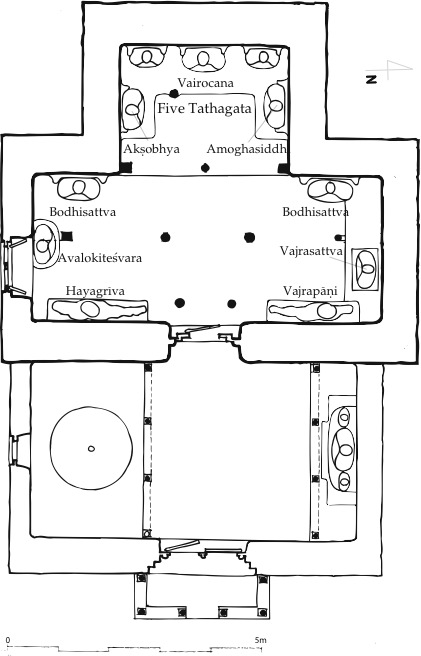
Lotsawa Lhakhang
Ropa (རོ་དཔག་) is the last major village in the Ropa or Gangyul valley, one of the western tributaries of the Sutlej in Upper Kinnaur. Lying at an altitude of 2950 metres, it can be reached from the main road along the Sutlej by a 17 km link road terminating at Ropa village.

Ropa is mentioned among the 21 smaller places where Rinchen Zangpo (རིན་ཆེན་བཟང་པོ་) is said to have founded a temple, and the older Buddhist temple at Ropa is in fact called the Translator’s Temple or Lotsawa Lhakhang (ལོ་ཙ་བ་ལྷ་ཁང་) in reference to this alleged foundation by the great translator. The temple has two distinct parts, the rather unusually shaped old core and a room built in front of it containing a prayer wheel and an image of Padmasambhava (◊ Ropa).
The shape of the inner, older part of the Temple is a small rectangular room with an niche on the long side of the rectangle. Measuring c. 3.25 metres, the niche is wider than the rectangular hall in front of it, which is c. 5.8 metres wide and c. 2.8 metres deep. The small temple has been altered considerably over the course of time. None of the original painting remains, and also its sculptures have been subject to numerous repairs and repainting.
Nevertheless, the origin of the large clay sculptures in temple can be attributed to Rinchen Zangpo's time on iconographic and stylistic grounds. The niche in the back of the temple is occupied by the sculptures of the five esoteric Buddhas. Two white Bodhisattvas seated in the posture of royal ease (lalitāsana) flank the niche, and two gate-keepers are located to either side of the entrance (◊ Ropa Clay Sculptures).
Ground plan of the Ropa temple by John Harrison, September 1998.
- Thakur, Laxman S. 2009. Sculptural production during the bstan pa phyi dar and its stylistic nomenclature: some examples from Khu nu of Rong Chung. The Tibet Journal 34/35, no. 3/2: 465-481.
- Luczanits, Christian. 2004. Buddhist Sculpture in Clay: Early Western Himalayan Art, late 10th to early 13th centuries. Chicago: Serindia: 57–62.
The quotation below is from a description of Mañjuśrī in the Mañjuśrīmūlakalpa. Dharmachakra Translation Committee. 2020. The Root Manual of the Rites of Mañjuśrī – Mañjuśrīmūlakalpa. 84000 Translating the Words of the Buddha, Toh 543: 2.148.
Sculptures in Wood
The Lotsawa Lhakhang also contains a pair of beautifully carved wooden images representing the Bodhisattvas Avalokiteśvara and Vajrasattva. When documented they have been placed against the side wall of the rectangular room (◊ Ropa Wood Sculptures).
A group of smaller wooden sculptures occupies the altar, their ancient forms and recent painting denying straight forward identification. The green Bodhisattva seated on a peacock represents a rare form of Mañjuśrī, who originally held a blue lily (utpala) in the left hand. Both, the braids behind his head and the bottom of the stalk of his flower attribute support this identification. The three-headed and six-armed yellow goddess is a rare form of Tārā. Both Buddha Amoghasiddhi on the central point of the crown and the garuḍa as her vehicle confirm a karma-family attribution. Her upper hands once held arrow and bow, the middle ones hold a vajra and perform gesture of threatening (tarjanīmudrā). The lower arms deviate from the description of the goddess preserved in Niṣpannayogāvalī 20. The representation of a donor couple at her feet indicates, that this form of Tārā was once worshipped as an independent goddess. She obviously was popular in Ropa, too, as her iconography is repeated in a later sculpture without the hints to her family association. Also the Sugatisaṃdarśana Avalokiteśvara behind the latter sculpture is evidence of the close association of many of the wooden sculptures at Ropa with deities popular in Kashmir.
The identifications proposed here partially correct those proposed in Thakur 2009.
